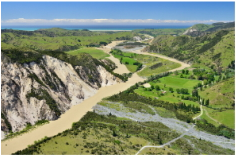Pure and Applied Geophysics Volume 157, Issue 11-12, December 2000Special Issues
Numerical Simulation of Localisation Phenomena in a Fault Zone
D. Place, P. MoraPages 1821-1845
Shear Heating in Granular Layers
K. Mair, C. MaronePages 1847-1866
Extension of the Lattice Solid Model to Incorporate Temperature Related Effects
S. Abe, P. Mora, D. PlacePages 1867-188
Hybrid Modelling of Coupled Pore Fluid-solid Deformation Problems
H. Sakaguchi, H.-B. MühlhausPages 1889-1904
Numerical Simulation of Rock Failure and Earthquake Process on Mesoscopic Scale
Y.C Wang, X.C. Yin, F.J. Ke, M.F. Xia, K.Y. PengPages 1905-1928
Damage Localization as a Possible Precursor of Earthquake Rupture
H.L. Li, Y.L. Bai, M.F. Xia, F.J. Ke, X.C. YinPages 1929-1943
Evolution-induced Catastrophe and its Predictability
Y.J. Wei, M.F. Xia, F.J. Ke, X.C. Yin, Y.L. BaiPages 1945-1957
Dynamic Propagation and Interaction of a Rupture Front on a Planar Fault
E. Fukuyama, R. MadariagaPages 1959-1979
Criticality of Rupture Dynamics in 3-D
R. Madariaga, K. B. OlsenPages 1981-2001
Spontaneous Rupture Propagation on a Non-planar Fault in 3-D Elastic Medium
H. Aochi, E. Fukuyama, M. Matsu’uraPages 2003-2027
Constraints on Stress and Friction from Dynamic Rupture Models of the 1994 Northridge, California, Earthquake
S.B. Nielsen, K.B. OlsenPages 2029-2046
Parallel 3-D Simulation of Ground Motion for the 1995 Kobe Earthquake: The Component Decomposition Approach
T. Furumura, K. KoketsuPages 2047-2062
Computer Simulation of Strong Ground Motion near a Fault Using Dynamic Fault Rupture Modeling: Spatial Distribution of the Peak Ground Velocity Vectors
T. MiyatakePages 2063-2081
Numerical Simulation of Dynamic Process of the Tangshan Earthquake by a New Method—LDDA
Y. Cai, T. He, R. WangPages 2083-2104
Nonlinear Structural Subsystem of GeoFEM for Fault Zone Analysis
M. Iizuka, H. Okuda, G. YagawaPages 2105-2124
3-D Physical Modelling of Stress Accumulation Processes at Transcurrent Plate Boundaries
C. Hashimoto, M. Matsu’uraPages 2125-2147
The Edges of Large Earthquakes and the Epicenters of Future Earthquakes: Stress-induced Correlations in Elastodynamic Fault Models
B.E. ShawPages 2149-2164
Precursory Seismic Activation and Critical-point Phenomena
J.B. Rundle, W. Klein, D.L. Turcotte, B.D. MalamudPages 2165-2182
Evolution of Stress Deficit and Changing Rates of Seismicity in Cellular Automaton Models of Earthquake Faults
D. Weatherley, S.C. Jaumé, P. MoraPages 2183-2207
Accelerating Seismic Energy Release and Evolution of Event Time and Size Statistics: Results from Two Heterogeneous Cellular Automaton Models
S.C. Jaumé, D. Weatherley, P. MoraPages 2209-2226
The Plausibility of Long-wavelength Stress Correlation or Stress Magnitude as a Mechanism for Precursory Seismicity: Results from Two Simple Elastic Models
M.E. WinterPages 2227-2248
Scale-dependence in Earthquake Processes and Seismogenic Structures
K. AkiPages 2249-2258
A Physical Scaling Relation Between the Size of an Earthquake and its Nucleation Zone Size
M. OhnakaPages 2259-2282
Regional Difference in Scaling Laws for Large Earthquakes and its Tectonic Implication
Y. Fujii, M. Matsu’uraPages 2283-2301
Continuous GPS Array and Present-day Crustal Deformation of Japan
T. Sagiya, S. Miyazaki, T. TadaPages 2303-2322
Implications of a Statistical Physics Approach for Earthquake Hazard Assessment and Forecasting
V.G. Kossobokov, V.I. Keilis-Borok, D.L. Turcotte…Pages 2323-2349
Application of Linked Stress Release Model to Historical Earthquake Data: Comparison between Two Kinds of Tectonic Seismicity
C. Lu, D. Vere-JonesPages 2351-2364
Development of a New Approach to Earthquake Prediction: Load/Unload Response Ratio (LURR) Theory
X.C. Yin, Y.C. Wang, K.Y. Peng, Y.L. Bai, H.T. Wang…Pages 2365-2383











评论已有 0 条